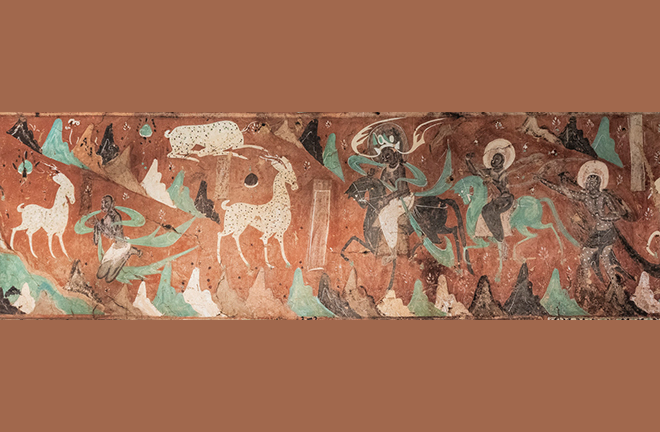The evolution of color art in Dunhuang murals

The color art of Dunhuang murals is an academic focus. Photo: TUCHONG
The Dunhuang murals, covering a total area of 45,000 square meters, form a rich tapestry of varied content, diverse themes, and distinctive colors. They represent the crystallization of Chinese culture and art. They are the products of the convergence and integration of religions, thoughts, societies, and cultures from different countries and regions in ancient times, epitomizing the openness and inclusiveness of Dunhuang art. The color art of the Dunhuang murals is magnificent and dazzling, and stands as a treasure trove of color mural artistry.
In recent years, the study of traditional Chinese color art has become a hot spot in academic circles. As an indispensable part of Chinese art history, the study of Dunhuang mural color art has gradually become an academic hot spot in terms of its artistic style, evolutionary patterns, and materials.
Origins of color art
As the theoretical founder of the study of Dunhuang mural art, Mr. Duan Wenjie was one of the pioneering scholars to conduct in-depth research on its evolutionary patterns. Mr. Duan believes that while the characteristics of early-stage color art of the Dunhuang murals inclines more towards Western styles, its color perception still adhered to traditional Chinese color application principles.
Mr. Chang Shuhong further proposed that the introduction of Buddhist culture deeply influenced Chinese artistic thought, but this influence was limited to the “flow,” not the “source.”
In his book Dunhuang Decorative Patterns, Guan Youhui proposed that the presentation of color patterns, in addition to their decorative function, also reflected the exchanges among different countries, ethnicities, societies, cultures and arts. It is not difficult to see that these discussions mostly adopt a macro perspective, but lack a clear and accurate outline of the evolutionary pattern.
Evolutionary patterns
Academic research on the color art style of the Dunhuang murals takes a predominantly macro perspective, mainly focusing on the murals presenting different themes such as figure painting and decorative patterns. This research not only includes analyses of the exchange and integration of the color art in the Dunhuang murals, but also discusses the influence of the application and dissemination of coloring techniques on the color art of mural paintings in different periods.
The application of various coloring techniques in the Dunhuang murals was driven by external factors as well as the intrinsic need for autonomous development. To a certain extent, it also reflected the recognition and creative adaptation of Buddhist culture by various countries and ethnic groups.
The research perspectives mentioned above primarily focus on identifying various mural techniques, with relatively little systematic and theoretical discussion on mural color art techniques. In ancient China, techniques were often considered as a matter of “techniques” rather than “Dao” [the natural way] and therefore received less attention. However, since it is a “technique,” it can be mastered and can reflect scientific principles. In the process of transforming “techniques” into “Dao,” different problems related to mural color art in different periods and the varying creative ideas of painters become evident.
Throughout the overall development and evolution of Dunhuang mural color art, materials and techniques have played a central role. Understanding and exploring various techniques and materials not only contributes to constructing a theoretical system of mural color art but also forms the foundation for advancing its practice. In the historical evolution of Dunhuang mural color art, the inheritance of materials and the continuation of techniques will certainly attract significant attention from researchers.
It is evident that the color art in the Dunhuang murals was carried by the spread of Buddhism during its long evolution, highlighting exchanges of Chinese and Western cultures, the flowing back of the Central Plains culture and the influence and integration among different arts. Researchers, primarily from an art studies perspective, have conducted multi-layered and multidimensional studies on issues related to the color art of the Dunhuang murals, resulting in a wealth of research achievements. However, as the primary perceptual element of the Dunhuang murals, the study of color art has progressed relatively slowly due to changes in the murals, a lack of documentation, and methodological limitations.
Pigment research
The study of color inevitably involves pigments. Research on the pigments used in the Dunhuang murals primarily focuses on two aspects: the materials and composition of pigments, and their sources and trade.
Since the 1950s, studies on Dunhuang mural pigments have advanced steadily, gradually becoming clearer and more detailed in terms of types, materials, compositions and origins. This has laid a solid foundation for further research on mural pigments. Of course, the issue of color extends beyond pigments alone. The long evolution of Dunhuang mural color art also encompasses the integration of cultures, environments, ethnicities, and changes. The influences of these factors on the configuration and aesthetics of Dunhuang mural color art requires further contemplation.
In short, academic research on the color art of the Dunhuang murals has mainly focused on exploring the color art of mural paintings in different periods, the analysis of color pigments, and the consideration of individual color changes. There has been less attention to the composition of color systems and their overall evolutionary patterns and characteristics, and related logical relationships. Moreover, the relationship between mural image styles and colors has not been thoroughly investigated. Consequently, the evolutionary patterns and characteristics of Dunhuang mural color art will be key areas of attention in the future.
Du Xingxing is an associate professor from the Academy of Fine Art and Design at Northwest Normal University.
Edited by ZHAO YUAN

 PRINT
PRINT CLOSE
CLOSE